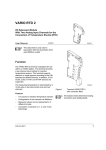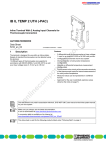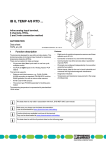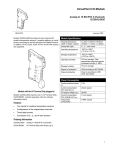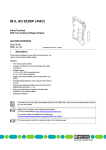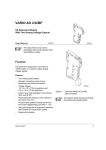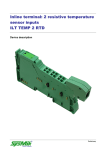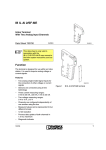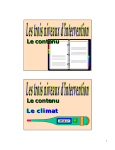Download Data Sheet DB EN IB IL TEMP 2 RTD (-PAC)
Transcript
IB IL TEMP 2 RTD (-PAC) D Inline Terminal With Two Analog Input Channels for the Connection of Temperature Shunts (RTD) TD 2R AUTOMATIONWORX Data Sheet 5755_en_04 1 © PHOENIX CONTACT - 04/2007 Description The terminal is designed for use within an Inline station. This terminal provides a two-channel input module for resistive temperature sensors. This terminal supports platinum and nickel sensors according to the DIN standard and SAMA Directive. In addition, sensors Cu10, Cu50, Cu53 as well as KTY81 and KTY84 are supported. The measuring temperature is represented by 16-bit values in two process data words (one word per channel). Features – – – – Two inputs for resistive temperature sensors Configuration of channels via the bus system Measured values can be represented in three different formats Connection of sensors in 2, 3, and 4-wire technology This data sheet is only valid in association with the IL SYS INST UM E user manual or the Inline system manual for your bus system. Make sure you always use the latest documentation. It can be downloaded at www.download.phoenixcontact.com. A conversion table is available on the Internet at www.download.phoenixcontact.com/general/7000_en_00.pdf. This data sheet is valid for the products listed on the following page: IB IL TEMP 2 RTD (-PAC) Table of Contents 1 Description.................................................................................................................................. 1 2 Ordering Data ............................................................................................................................. 3 3 Technical Data............................................................................................................................ 3 4 Local Diagnostic Indicators......................................................................................................... 5 4.1 4.2 4.3 4.4 Local Diagnostic Indicator .............................................................................................................................. 5 Function Identification .................................................................................................................................... 5 Terminal Point Assignment for 2/3-Wire Termin. ........................................................................................... 5 Terminal Point Assignment for 4-Wire Termin. on Channel 1 and 2-Wire Termin. on Channel 2.................. 5 5 Safety Notes ............................................................................................................................... 5 6 Installation Instructions ............................................................................................................... 6 7 Internal Circuit Diagram.............................................................................................................. 6 8 Electrical Isolation....................................................................................................................... 7 9 Connection Notes .................................................................................................................................................. 7 9.1 9.2 9.3 Thermocouple Connection ............................................................................................................................. 7 Shield Connection .......................................................................................................................................... 7 Sensor Connection in 4-Wire Technology...................................................................................................... 7 10 Connection Examples................................................................................................................. 8 11 Programming Data ..................................................................................................................... 9 12 Process Data .............................................................................................................................10 12.1 12.2 12.3 12.4 Output Data Words for Configuring the Terminal (See Page 11)................................................................. 10 Assignment of Terminal Points to the Input Data Words (See Page 14) ..................................................... 10 OUT Process Data ....................................................................................................................................... 11 IN Process Data ........................................................................................................................................... 14 13 Formats for Representing Measured Values.............................................................................16 13.1 13.2 13.3 Format 1: IB Standard (Default Setting)....................................................................................................... 16 Format 2....................................................................................................................................................... 18 Format 3....................................................................................................................................................... 19 14 Measuring Ranges ....................................................................................................................20 14.1 14.2 Measuring Ranges Depending on the Resolution (Format IB Standard)..................................................... 20 Input Measuring Values ............................................................................................................................... 21 15 Measuring Errors .......................................................................................................................22 15.1 15.2 Systematic Measuring Errors During Temperature Measurement Using Resistance Thermometers ......... 22 Systematic Errors During Temperature Measurement Using 2-Wire Technology ....................................... 24 16 Tolerance and Temperature Response.....................................................................................26 5755_en_04 PHOENIX CONTACT 2 IB IL TEMP 2 RTD (-PAC) 2 Ordering Data Products Description Type Order No. Pcs./Pkt. Inline terminal with two resistive temperature sensor inputs, without accessories IB IL TEMP 2 RTD 2726308 1 Inline terminal with two resistive temperature sensor inputs, complete with accessories (connector and labeling field) IB IL TEMP 2 RTD-PAC 2861328 1 A connector with shield connection is needed for the complete fitting of the IB IL TEMP 2 RTD terminal. Accessories Description Type Order No. Pcs./Pkt. Inline shield connector for analog Inline terminals IB IL SCN-6 SHIELD 2726353 5 Documentation Description Type Order No. Pcs./Pkt. User manual: "Automation Terminals of the Inline Product Range" IL SYS INST UM E 2698737 1 User manual: "Configuring and Installing the INTERBUS Inline Product Range" IB IL SYS PRO UM E 2743048 1 3 Technical Data General Data Housing dimensions (width x height x depth) 12.2 mm x 120 mm x 66.6 mm Weight 46 g (without connector); 67 g (with connector) Operating mode Process data mode with 2 words Connection method for sensors 2, 3, and 4-wire technology Ambient temperature (operation) -25°C to +55°C Ambient temperature (storage/transport) -25°C to +85°C Permissible humidity (operation/storage/transport) 10% to 95% according to DIN EN 61131-2 Permissible air pressure (operation/storage/transport) 70 kPa to 106 kPa (up to 3000 m above sea level) Degree of protection IP20 according to IEC 60529 Class of protection Class 3 according to VDE 0106, IEC 60536 Connection data for Inline connector Connection method Spring-cage terminals Conductor cross-section 0.2 mm2 to 1.5 mm2 (solid or stranded), 24 - 16 AWG Interface Local bus Data routing Transmission Speed IB IL TEMP 2 RTD; IB IL TEMP 2 RTD-PAC 500 kbps Power Consumption Communications power UL 7.5 V Current consumption at UL 43 mA (typical) I/O supply voltage UANA 24 V DC Current consumption at UANA 11 mA (typical) Total power consumption 590 mW (typical) 5755_en_04 PHOENIX CONTACT 3 IB IL TEMP 2 RTD (-PAC) Supply of the Module Electronics and I/O Through the Bus Coupler/Power Terminal Connection method Potential routing Analog Inputs Number Two inputs for resistive temperature sensors Connection of the signals 2, 3 or 4-wire, shielded sensor cable Sensor types that can be used Pt, Ni, Cu, KTY Characteristics standards According to DIN/according to SAMA Conversion time of the A/D converter 120 µs, typical Process data update Depending on the connection method Both channels in 2-wire technology 20 ms One channel in 2-wire technology/one channel in 4-wire technology 20 ms Both channels in 3-wire technology 32 ms Safety Equipment None Electrical Isolation To provide electrical isolation between the logic level and the I/O area, it is necessary to provide the bus coupler supply UBK and the I/O supply (UM/US) from separate power supply units. Interconnection of the power supply units in the 24 V area is not permitted. Common Potentials 24 V main voltage UM, 24 V segment voltage US, and GND have the same potential. FE is a separate potential area. Separate Potentials in the Terminal Test Distance Test Voltage 7.5 V supply (bus logic) / 24 V analog supply (analog I/O) 500 V AC, 50 Hz, 1 min 7.5 V supply (bus logic) / functional earth ground 500 V AC, 50 Hz, 1 min 24 V analog supply (analog I/O) / functional earth ground 500 V AC, 50 Hz, 1 min Error Messages to the Higher-Level Control or Computer System Failure of the internal voltage supply Yes Failure of or insufficient communications power UL Yes, I/O error message sent to the bus coupler Error Messages via Process Data I/O error/user error Yes (see page 15) Approvals Information on current approvals can be found on the Internet at www.download.phoenixcontact.com. 5755_en_04 PHOENIX CONTACT 4 IB IL TEMP 2 RTD (-PAC) 4 Local Diagnostic Indicators 4.1 Local Diagnostic Indicator Desig. D D RTD 4.2 Color Meaning Green Diagnostics Function Identification Green 4.3 Terminal Point Assignment for 2/3-Wire Termin. D RTD 1 2 1.1 1 1 2.1 1.2 2 2 2.2 1.3 3 3 2.3 1.4 4 4 2.4 Signal Assignment I1+ I1- RTD of sensor 1 1.3 2.1 2.2 U1I2+ I2- 2.3 1.4, 2.4 U2Shield 4.4 5755A002 Figure 1 Terminal Points 1.1 1.2 Terminal with appropriate connector Constant current supply Measuring input of sensor 1 RTD of sensor 2 Constant current supply Measuring input of sensor 2 Shield connection (channel 1 and 2) Terminal Point Assignment for 4-Wire Termin. on Channel 1 and 2-Wire Termin. on Channel 2 Terminal Points 1.1 1.2 Signal Assignment I1+ I1- RTD of sensor 1 1.3 2.3 2.1 2.2 U1U1+ I2+ I2- 1.4, 2.4 Shield Constant current supply Measuring input of sensor 1 Measuring input of sensor 1 RTD of sensor 2 Constant current supply Shield connection (channel 1 and 2) In 4-wire technology a sensor can only be connected to channel 1. 5 Safety Notes During configuration, ensure that no isolating voltage is specified between the analog inputs and the local bus. During thermistor detection this, for example, means that the user has to provide signals with safe isolation, if applicable. 5755_en_04 PHOENIX CONTACT 5 IB IL TEMP 2 RTD (-PAC) 6 Installation Instructions High current flowing through potential jumpers UM and US leads to a temperature rise in the potential jumpers and inside the terminal. Observe the following instructions to keep the current flowing through the potential jumpers of the analog terminals as low as possible: Create a separate main circuit for all analog terminals If this is not possible in your application and if you are using analog terminals in a main circuit together with other terminals, place the analog terminals behind all the other terminals at the end of the main circuit. 7 Internal Circuit Diagram Key: Local bus OPC OPC Protocol chip Optocoupler UL+ UANA UL- DC/DC converter with electrical isolation X X X 24 V µ P M U X ±5V R E F µP Microprocessor with multiplexer and analog/digital converter Reference voltage REF MUX E E P R O M EEPROM Electrically erasable programmable readonly memory Amplifier Other symbols used are explained in the IL SYS INST UM E user manual or in the system manual for your bus system. +24 V (US) 1 +24 V (UM) 5755B003 Figure 2 5755_en_04 Internal wiring of the terminal points PHOENIX CONTACT 6 IB IL TEMP 2 RTD (-PAC) 8 Electrical Isolation Local bus (IN) Bus interface OPC UL (7,5 V DC) 9 Connection Notes 9.1 Thermocouple Connection Local bus (OUT) In 4-wire technology a sensor can only be connected to channel 1. In this case, the sensor on channel 2 can only be connected in 2-wire technology! UL (7,5 V DC) UANA (24 V DC) UANA (24 V DC) 24 V ±5V ±5V A I/O interface and microprocessor Ground potential Analog inputs Figure 3 B Electrical isolation between area A and B 9.2 Shield Connection The connection examples show how to connect the shield (Figure 4). 5755A007 Electrical isolation of the individual function areas Connect the shielding to the Inline terminal using the shield connection clamp. The clamp connects the shield directly to FE on the terminal side. Additional wiring is not necessary. Isolate the shield at the sensor. 9.3 Sensor Connection in 4-Wire Technology Always connect temperature shunts using shielded, twisted-pair cables. 5755_en_04 PHOENIX CONTACT 7 IB IL TEMP 2 RTD (-PAC) 10 Connection Examples When connecting the shield at the terminal you must insulate the shield on the sensor side (shown in gray in Figure 4 and Figure 5). Use a connector with shield connection when installing the sensors. Figure 4 shows the connection schematically (without shield connector). Connection of Passive Sensors D D 2 R T D 2 R T D A 1 B 2 A 1 B 2 I1+ 1 1 I2+ I1+ 1 1 I2+ I12 2 I2- I12 2 I2- 3 3 4 4 U 2 U U 1 3 3 1 + 4 4 5 7 5 5 B 0 1 1 5 7 5 5 B 0 0 4 Figure 4 A B Connection of sensors in 2 and 3-wire technology with shield connection Channel 1; 2-wire technology Channel 2; 3-wire technology 5755_en_04 Figure 5 A B Connection of sensors in 4 and 2-wire technology with shield connection Channel 1; 4-wire technology Channel 2; 2-wire technology PHOENIX CONTACT 8 IB IL TEMP 2 RTD (-PAC) 11 Programming Data Local Bus (INTERBUS) ID code Length code Input address area Output address area Parameter channel (PCP) Register length (bus) 7Fhex (127dec) 02hex 4 bytes 4 bytes 0 bytes 4 bytes Other Bus Systems For the configuration data of other bus systems, please refer to the appropriate electronic device data sheet (e.g., GSD, EDS). 5755_en_04 PHOENIX CONTACT 9 IB IL TEMP 2 RTD (-PAC) 12 Process Data 12.1 Output Data Words for Configuring the Terminal (See Page 11) (Word.bit) view Word Bit (Byte.bit) view Byte Bit Channel 1 Assignment (Word.bit) view Word Bit (Byte.bit) view Byte Bit Channel 2 Assignment 12.2 15 14 7 6 Configuration 15 14 7 6 Configuration 13 12 11 Byte 0 5 4 3 Connection method 13 12 11 Byte 2 5 4 3 Connection method 10 Word 0 9 8 7 2 1 0 R0 7 6 Resolution 10 Word 1 9 8 7 2 1 0 R0 6 6 7 6 Resolution 5 4 3 2 1 0 Byte 1 5 4 3 2 1 0 Format Sensor type 5 4 3 2 1 0 Byte 3 5 4 3 2 1 0 Format Sensor type Assignment of Terminal Points to the Input Data Words (See Page 14) (Word.bit) view Word Bit (Byte.bit) view Byte Bit Terminal points Signal channel 1 Signal reference Shielding (FE) (Word.bit) view Word Bit (Byte.bit) view Byte Bit Terminal points Signal channel 2 Signal reference Shielding 5755_en_04 15 12 11 10 9 Byte 0 7 6 5 4 3 2 1 Terminal point 1.1: I1+ sensor 1 Terminal point 1.2: I1- sensor 1 Terminal point 1.4 15 14 14 13 13 12 11 10 9 Byte 2 7 6 5 4 3 2 1 Terminal point 2.1: I2+ sensor 2 Terminal point 2.2: I2- sensor 2 Terminal point 2.4 Word 0 8 7 6 5 0 6 5 7 4 3 Byte 1 4 3 2 1 0 2 1 0 2 1 0 2 1 0 Terminal point 1.3 U1- sensor 1 Word 1 8 7 6 5 0 6 5 7 4 3 Byte 3 4 3 Terminal point 2.3 U1+ sensor 2 PHOENIX CONTACT 10 IB IL TEMP 2 RTD (-PAC) 12.3 OUT Process Data The terminal channels can be configured using the two process data output words. The following configuration options exist for each channel independent of the other channel: – Connection type of the sensor – Value of reference resistance R0 – Resolution settings – Selecting the formats for the representation of measured values – Setting the sensor type With regard to the connection method the two channels are dependent on each other. If 4-wire mode is activated for channel 1, channel 2 can only be operated using 2-wire connection method. 4-wire connection method is only available for channel 1. Configuration errors are indicated by the corresponding error code, as long as the IB standard format is configured as the format for representing the measured values. The configuration settings are only stored in a volatile memory. They must be transmitted in each bus cycle. After the Inline station has been powered up, the "Measured value invalid" message (error code 8004hex) appears in the IN process data words. After 1 s (maximum) the preset configuration is accepted and the first measured value is available. Default: Connection: R0: Resolution: Format: Sensor type: 2-wire technology 100 Ω 0.1°C Format 1 (IB standard) Pt100 (DIN) If you change the configuration, the corresponding channel is re-initialized. The "Measured value invalid" message (error code 8004hex) appears in the process data output words for 100 ms (maximum). If the configuration is invalid, the "Configuration invalid" message is output (error code 8010hex). Please note that extended diagnostics is only possible if IB standard is configured as the format for representing the measured values. Since this format is preset on the terminal, it can be used straight away after power up. One process data output word is available for the configuration of each channel. Process data word 0 Process data word 1 Channel 1 Channel 2 MSB 15 LSB 14 13 12 Configuration Connection type Figure 6 5755_en_04 11 10 R0 9 8 7 6 5 4 Resolution Format 3 2 1 0 Sensor type 5755A006 Process data output words PHOENIX CONTACT 11 IB IL TEMP 2 RTD (-PAC) Bit 15 and Bit 14: You must set bit 15 of the corresponding output word to 1 to configure the terminal or a certain channel. If bit 15 = 0, the pre-set configuration is active. Bit 14 is of no importance at present, therefore it should be set to 0. Bit 13 and Bit 12: Code dec bin 0 00 1 01 2 10 3 11 Bit 11 to Bit 8 Code dec Connection Method 3-wire 2-wire 4-wire (channel 1 only) Reserved R0 [Ω] bin Code dec 8 R0 [Ω] bin 0 0000 100 1000 240 1 0001 10 9 1001 300 2 0010 20 10 1010 400 3 0011 30 11 1011 500 4 0100 50 12 1100 1000 5 0101 120 13 1101 1500 6 0110 150 14 1110 2000 7 0111 200 15 1111 3000 (can be set) Bit 7 and Bit 6: Code dec bin 0 00 1 01 2 10 3 11 5755_en_04 Resolution for Sensor Type 0 to 10 13 0.1°C 1% 0.01°C 0.1% 0.1°F Reserved 0.01°F 14 0.1 Ω 0.01 Ω Reserved 15 1Ω 0.1 Ω Reserved PHOENIX CONTACT 12 IB IL TEMP 2 RTD (-PAC) Bit 5 and Bit 4: Code dec bin 0 00 1 01 2 10 3 11 Format Format 1: IB standard (15 bits + sign bit with extended diagnostics) Compatible with ST format Format 2 (12 bits + sign bit + 3 diagnostic bits) Format 3 (15 bits + sign bit) Reserved Bit 3 to Bit 0: Code Sensor Type dec bin Code dec Sensor Type bin 0 0000 Pt DIN 8 1000 Ni500 (Viessmann) 1 0001 Pt SAMA 9 1001 KTY81-110 2 0010 Ni DIN 10 1010 KTY84 3 0011 Ni SAMA 11 1011 Reserved 4 0100 Cu10 12 1100 Reserved 5 0101 Cu50 13 1101 Potentiometer [%] 6 0110 Cu53 14 1110 Linear R: 0 through 400 Ω 7 0111 Ni1000 (Landis & Gyr) 15 1111 Linear R: 0 through 4000 Ω 5755_en_04 PHOENIX CONTACT 13 IB IL TEMP 2 RTD (-PAC) 12.4 IN Process Data On each channel the measured values are transmitted to the controller board or the computer by means of the IN process data words. The three formats for representing the input data are shown in Figure 7. For more detailed information on the formats, please refer to Section "Formats for Representing Measured Values" on page 16. Process data word 0 Process data word 1 Channel 1 Channel 2 MSB LSB 15 14 13 12 11 10 9 8 7 6 5 4 3 2 1 0 8 7 6 5 4 3 2 1 0 Format 1 Format 3 AV SB 15 14 13 12 11 10 9 AV SB 0 Format 2 OC OR 5755A009 Figure 7 MSB LSB SB AV 0 OC OR Sequence of the IN process data words and representation of the bits of the first process data word in the different formats Most significant bit Least significant bit Sign bit Analog value Reserved Open circuit/short circuit Overrange 5755_en_04 PHOENIX CONTACT 14 IB IL TEMP 2 RTD (-PAC) The "IB standard" process data format 1 supports extended diagnostics. The following error codes are possible: Code (hex) 8001 8002 8004 8010 8040 8080 Error Overrange Open circuit or short circuit (only available for the temperature range) Measured value invalid / no valid measured value available Invalid configuration Terminal faulty Underrange Open Circuit/Short Circuit Detection: Open circuit is detected according to the following table: Faulty Sensor Cable I+ IU+ UYes – No 5755_en_04 Temperature Measuring Range 2-Wire 3-Wire 4-Wire Yes Yes Yes Yes Yes Yes – – Yes – Yes Yes Resistance Measuring Range 2-Wire 3-Wire 4-Wire Yes Yes No Yes Yes No – – Yes – Yes Yes Open circuit/short circuit is detected. The cable is not connected when using this connection method. Open circuit/short circuit is not detected because the value is a valid measured value. PHOENIX CONTACT 15 IB IL TEMP 2 RTD (-PAC) 13 Formats for Representing Measured Values 13.1 Format 1: IB Standard (Default Setting) The measured value is represented in bits 14 through 0. An additional bit (bit 15) is available as a sign bit. This format supports extended diagnostics. Values > 8000hex indicate an error. The error codes are listed on on page 15. Measured value representation in format 1 (IB standard; 15 bits) 15 14 SB 13 12 11 SB AV Sign bit Analog value 10 9 8 7 6 AV 5 4 3 2 1 0 Typical Analog Values Depending on the Resolution Sensor Type (Bits 3 to 0) 0 to 10 13 14 15 Resolution (Bits 7 and 6) 00bin / 10bin 00bin 00bin 00bin Process Data Item (= Analog Value) 1% [%] 0.1 Ω [Ω] 1Ω [Ω] hex dec 0.1°C / 0.1°F [°C] / [°F] 8002 – Open circuit – – – 8001 – Overrange (see page 21) – 400 4000 2710 10000 1000.0 – – – 0FA0 4000 400.0 4000 (40 x R0) 400 4000 00A0 10 1.0 10 (0.10 x R0) 1.0 10 0001 1 0.1 1 (0.01 x R0) 0.1 1 0000 0 0 0 0 0 FFFF -1 FC18 -1000 -0.1 – – – -100.0 – – – 8080 Underrange (see page 21) – – – 8002 Short circuit – – – 5755_en_04 PHOENIX CONTACT 16 IB IL TEMP 2 RTD (-PAC) Sensor Type (Bits 3 to 0) 0 to 10 13 14 15 Resolution (Bits 7 and 6) 01bin / 11bin 01bin 01bin 01bin 0.01°C / 0.01°F [°C] / [°F] 0.1% [%] 0.01 Ω [Ω] 0,.1 Ω [Ω] Process Data Item (= Analog Value) hex dec 8002 – Open circuit – – – 8001 – > 325.12 Overrange (see page 21) – 325.12 3251.2 2710 10000 100.00 1000.0 (10 x R0) 100.00 1000.0 03E8 4000 10.00 100.0 (1 x R0) 10.00 100.0 0001 1 0.01 0.1 (0.01 x R0) 0.01 0.1 0000 0 FFFF -1 D8F0 -10000 0 0 0 -0.01 0 – – – -100.00 – – – 8080 Underrange (see page 21) – – – 8002 Short circuit – – – If the measured value is outside the representation area of the process data, the "Overrange" or "Underrange" error message is displayed. 5755_en_04 PHOENIX CONTACT 17 IB IL TEMP 2 RTD (-PAC) 13.2 Format 2 This format can be selected for each channel using bits 5 and 4 (bit combination 01bin) of the corresponding process data output word. The measured value is represented in bits 14 through 3. The remaining 4 bits are sign and error bits. Measured value representation in format 2 (12 bits) 15 14 SB 13 12 11 10 9 8 AV SB AV 0 OC OR Sign bit Analog value Reserved Open circuit/short circuit Overrange 7 6 5 4 3 2 0 1 0 OC OR Typical Analog Values Depending on the Resolution Sensor Type (Bits 3 to 0) Resolution (Bits 7 and 6) Process Data Item (= Analog Value) hex dec xxxx xxxx xxxx xxx1bin 2710 03E8 0008 0000 FFF8 FC18 xxxx xxxx xxxx xxx1bin 10000 1000 8 0 -8 -1000 xxxx xxxx xxxx xx1xbin AV x RTD Sensor (0 to 13) 00bin / 10bin 01bin / 11bin 0.1°C / 0.1°F 0.01°C / 0.01°F [°C] / [°F] [°C] / [°F] Overrange (AV = positive final value from the table on page 21) 1000.0 100.00 100.0 10.00 0.8 0.08 0 0 -0.8 -0.08 -100.0 -10.00 Underrange (AV = negative final value from the table on page 21) Open circuit/short circuit (AV = negative final value from the table on page 21) Analog value Can accept values 0 or 1 If the measured value is outside the representation area of the process data, bit 0 is set to 1. In the event of an open circuit/short circuit, bit 1 is set to 1. 5755_en_04 PHOENIX CONTACT 18 IB IL TEMP 2 RTD (-PAC) 13.3 Format 3 This format can be selected for each channel using bits 5 and 4 (bit combination 10bin) of the corresponding process data output word. The measured value is represented in bits 14 through 0. An additional bit (bit 15) is available as a sign bit. Measured value representation in format 3 (15 bits) 15 14 SB 13 12 SB Sign bit 11 10 9 8 7 6 AV 5 4 3 AV 2 1 0 Analog value Typical Analog Values Depending on the Resolution Sensor Type (Bits 3 to 0) Resolution (Bits 7 and 6) Process Data Item (= Analog Value) hex dec 7FFF 32767 Upper limit value* + 1 LSB 7D00 32000 2710 10000 000A 10 0001 1 0000 0 FFFF -1 FC18 -1000 Lower limit value* - 1 LSB Lower limit value* - 2 LSB Sensor Type (Bits 3 to 0) Resolution (Bits 7 and 6) Process Data Item (= Analog Value) hex dec 7FFF 32767 Upper limit value* + 1 LSB 7D00 32000 2710 10000 0001 1 0000 0 FFFF -1 D8F0 -10000 Lower limit value* - 1 LSB Lower limit value* - 2 LSB * RTD Sensor (0 to 10) 00bin / 10bin 0.1°C / 0.1°F [°C] / [°F] Linear Resistance (15) 00bin 1Ω [Ω] – Overrange – 1000.0 1 0.1 0 -0.1 -100.0 Underrange Open circuit/short circuit > 2048 – 2000 625 0.625 0.0625 0 – – – – RTD Sensor (0 to 10) 01bin / 11bin 0.01°C / 0.01°F [°C] / [°F] Linear Resistance (15) 01bin 0,1 Ω [Ω] – Overrange 320.00 100.0 0.1 0 -1.0 -100.0 Underrange Open circuit/short circuit > 4096 – 4000 1250 0.125 0 – – – – The limit values can be found on page 21. 5755_en_04 PHOENIX CONTACT 19 IB IL TEMP 2 RTD (-PAC) 14 Measuring Ranges 14.1 Measuring Ranges Depending on the Resolution (Format IB Standard) Resolution 00 01 10 11 Temperature Sensors -273°C up to +3276.8°C resolution: 0.1°C -273°C up to +327.68°C resolution: 0.01°C -459°F up to +3276.8°F resolution: 0.1°F -459°F up to +327.68°F resolution: 0.01°F Temperature values can be converted from °C to °F with this formula: T [° F ] = T [° C ] x 9 5 + 3 2 Where: T [°F] T [°C] 5755_en_04 Temperature in °F Temperature in °C PHOENIX CONTACT 20 IB IL TEMP 2 RTD (-PAC) 14.2 Input Measuring Values No. Input Sensor Type Measuring Range (Software-Supported) Lower Limit Upper Limit -200°C +850°C -200°C +850°C -60°C +180°C -60°C +180°C Cu10 -70°C +500°C 5 Cu50 -50°C +200°C 6 Cu53 -50°C +180°C 0 Pt R0 10 Ω to 3000 Ω acc. to DIN 1 Pt R0 10 Ω to 3000 Ω acc. to SAMA 2 Ni R0 10 Ω to 3000 Ω acc. to DIN Ni R0 10 Ω to 3000 Ω acc. to SAMA 3 Temperature sensors 4 7 Ni1000 L&G -50°C +160°C 8 Ni500 (Viessmann) -60°C +250°C 9 KTY81-110 -55°C +150°C 10 KTY84 -40°C +300°C 0% 4 kΩ / R0 x 100% (400%, maximum) 0Ω 400 Ω 0Ω 4000 Ω 11 Reserved 12 13 14 15 Relative potentiometer range Linear resistance measuring range The number (No.) corresponds to the code of the sensor type in bit 3 through bit 0 of the process data output word. 5755_en_04 PHOENIX CONTACT 21 IB IL TEMP 2 RTD (-PAC) 15 Measuring Errors 15.1 Systematic Measuring Errors During Temperature Measurement Using Resistance Thermometers When measuring temperatures using resistance thermometers, systematic measuring errors are often the cause of incorrectly measured results. There are three main ways to connect the sensors: 2, 3, and 4-wire technology. 4-Wire Technology 3-Wire Technology 4-wire technology is the most precise way of measuring (see Figure 8). D D 2 R T D 2 R T D 1 1 IK R L ϑ R U M L IK 1 1 I2 2 R I+ U ~ ϑ 2 L I+ ϑ 3 R L U M ~ ϑ 2 1 1 I2 2 U 3 3 4 4 3 U + 4 4 5 7 5 5 B 0 1 8 5 7 5 5 B 0 1 2 Figure 8 Connection of resistance thermometers in 4-wire technology In 4-wire technology, a constant current is sent through the sensor via the I+ and I- cables. Two further cables U+ and U- can be used to tap and measure the temperature-related voltage at the sensor. The cable resistances have absolutely no effect on the measurement. 5755_en_04 Figure 9 Connection of resistance thermometers in 3-wire technology In 3-wire technology, the effect of the cable resistance on the measured result in the terminal is eliminated or minimized by multiple measuring of the temperaturerelated voltage and corresponding calculations. The results are almost as good in terms of quality as with 4-wire technology in Figure 8. However, 4-wire technology offers better results in environments with heavy noise. PHOENIX CONTACT 22 IB IL TEMP 2 RTD (-PAC) 2-Wire Technology D 2 R T D 1 R IK L ϑ U R M ~ ϑ I+ 2 1 2 2 3 3 4 4 I- 1 L 5 7 5 5 0 0 1 3 Figure 10 Connection of resistance thermometers in 2-wire technology 2-wire technology is a cost-effective connection method. The U+ and U- cables are no longer needed. The temperature-related voltage is not directly measured at the sensor and therefore not falsified by the two cable resistances RL (see Figure 10). The measuring errors that occur can make the entire measurement unusable (see diagrams in Figure 11 to Figure 13). However, these diagrams also show the positions in the measuring system where steps can be taken to minimize these errors. 5755_en_04 PHOENIX CONTACT 23 IB IL TEMP 2 RTD (-PAC) 15.2 Systematic Errors During Temperature Measurement Using 2-Wire Technology 15.0 K 12.0 DT 9.0 (1) (2) 6.0 (3) 3.0 0.0 0.0 2.5 5.0 7.5 10.0 12.5 15.0 6.0 K 5.0 DT 4.0 3.0 2.0 1.0 0.0 0 17.5 m 20.0 l 0.1 0.2 0.3 0.4 0.5 0.6 0.7 57551014 Figure 11 Systematic temperature measuring error ΔT depending on the cable length l Curves depending on the cable diameter A (1) (2) (3) Temperature measuring error for A = 0.14 mm2 Temperature measuring error for A = 0.25 mm2 Temperature measuring error for A = 0.50 mm2 (Measuring error valid for: copper cable χ = 57 m/Ωmm2, TA = 25°C and Pt100 sensor) 0.8 0.9 m 1.0 l 57550015 Systematic temperature measuring error ΔT depending on the cable diameter A Figure 12 (Measuring error valid for: Copper cable χ = 57 m/Ωmm2, TA = 25°C, l = 5 m and Pt100 sensor) 2.5 K 2.0 DT 1.5 1.0 0.5 0.0 -30 -20 -10 0 +10 +20 +30 +40 +50 °C +60 TA 57550016 Figure 13 Systematic temperature measuring error ΔT depending on the cable temperature TA (Measuring error valid for: Copper cable χ = 57 m/Ωmm2, l = 5 m, A = 0.25 mm2 and Pt100 sensor) 5755_en_04 PHOENIX CONTACT 24 IB IL TEMP 2 RTD (-PAC) All diagrams show that the increase in cable resistance causes the measuring error. A considerable improvement is made through the use of Pt1000 sensors. Due to the 10-fold higher temperature coefficient α (α = 0.385 Ω/K for Pt100 to α = 3.85 Ω/K for Pt1000) the effect of the cable resistance on the measurement is decreased by factor 10. All errors in the diagrams above would be reduced by factor 10. Diagram 1 clearly shows the influence of the cable length on the cable resistance and therefore on the measuring error. The solution is to use the shortest possible sensor cables. Diagram 2 shows the influence of the cable diameter on the cable resistance. It can be seen that cables with a diameter of less than 0.5 mm2 cause errors to increase exponentially. Diagram 3 shows the influence of the ambient temperature on the cable resistance. This parameter does not play a great role and can hardly be influenced but it is mentioned here for the sake of completeness. The formula for calculating the cable resistance is as follows: L = L = R R R L 2 0 l c x A 1 x ( 1 + 0 .0 0 4 3 x T A) K 1 x ( 1 + 0 .0 0 4 3 K x T A) Where: RL RL20 l χ A 0.0043 1/K TA Cable resistance in Ω Cable resistance at 20°C in Ω Cable length in m Specific electrical resistance of copper in Ωmm2/m Cable cross-section in mm2 Temperature coefficient for copper Ambient temperature (cable temperature) in °C Since there are two cable resistances in the measuring system (forward and return), the value must be doubled. The absolute measuring error in Kelvin [K] is provided for platinum sensors according to DIN using the average temperature coefficient α (α = 0.385 Ω/K for Pt100; α = 3.85 Ω/K for Pt1000). 5755_en_04 PHOENIX CONTACT 25 IB IL TEMP 2 RTD (-PAC) 16 Tolerance and Temperature Response Typical Measuring Tolerances at 25°C Temperature Sensors Pt00 Pt1000 Ni100 Ni1000 Cu50 Ni1000 L&G Ni500 Viessmann KTY81-110 KTY84 Linear Resistance 0 Ω to 400 Ω 0 Ω to 4 kΩ α: x: α at 100°C 2-Wire Technology Relative [%] Absolute 3-Wire Technology Relative [%] Absolute 4-Wire Technology Relative [%] Absolute 0.385 Ω/K 3.85 Ω/K 0.617 Ω/K 6.17 Ω/K 0.213 Ω/K 5.6 Ω/K 2.8 Ω/K 10.7 Ω/K 6.2 Ω/K ±0.03 + x ±0.04 + x ±0.09 + x ±0.11 + x ±0.24 + x ±0.13 + x ±0.17 + x ±0.07 + x ±0.06 + x ±0.26 K + x ±0.31 K + x ±0.16 K + x ±0.2 K + x ±0.47 K + x ±0.21 K + x ±0.43 K + x ±0.11 K + x ±0.19 K + x ±0.03 ±0.04 ±0.09 ±0.11 ±0.24 ±0.13 ±0.17 ±0.07 ±0.06 ±0.26 K ±0.31 K ±0.16 K ±0.2 K ±0.47 K ±0.21 K ±0.43 K ±0.11 K ±0.19 K ±0.02 ±0.03 ±0.07 ±0.09 ±0.18 ±0.11 ±0.14 ±0.06 ±0.05 ±0.2 K ±0.26 K ±0.12 K ±0.16 K ±0.35 K ±0.18 K ±0.36 K ±0.09 K ±0.16 K ±0.025 + x ±0.03 + x ±100 mΩ + x ±1.2 Ω + x ±0.025 ±0.03 ±100 mΩ ±1.2 Ω ±0.019 ±0.025 ±75 mΩ ±1 Ω Average sensitivity for the calculation of tolerance values. Additional error due to connection using 2-wire technology (see "Systematic Errors During Temperature Measurement Using 2-Wire Technology" on page 24). 5755_en_04 PHOENIX CONTACT 26 IB IL TEMP 2 RTD (-PAC) Maximum Measuring Tolerances at 25°C Temperature Sensors Pt100 Pt1000 Ni100 Ni1000 Cu50 Ni1000 L&G Ni500 Viessmann KTY81-110 KTY84 α at 100°C 2-Wire Technology Relative [%] Absolute 3-Wire Technology Relative [%] Absolute 4-Wire Technology Relative [%] Absolute 0.385 Ω/K 3.85 Ω/K 0.617 Ω/K 6.17 Ω/K 0.213 Ω/K 5.6 Ω/K 2.8 Ω/K 10.7 Ω/K 6.2 Ω/K ±0.12 + x ±0.15 + x ±0.36 + x ±0.45 + x ±0.47 + x ±0.56 + x ±0.72 + x ±0.31 + x ±0.27 + x ±1.04 K + x ±1.3 K + x ±0.65 K + x ±0.81 K + x ±0.94 K + x ±0.89 K + x ±1.79 K + x ±0.47 K + x ±0.81 K + x ±0.12% ±0.15% ±0.36% ±0.45% ±0.47% ±0.56% ±0.72% ±0.31% ±0.27% ±1.04 K ±1.3 K ±0.65 K ±0.81 K ±0.94 K ±0.89 K ±1.79 K ±0.47 K ±0.81 K ±0.10% ±0.12% ±0.29% ±0.36% ±0.38% ±0.44% ±0.57% ±0.25% ±0.22% ±0.83 K ±1.04 K ±0.52 K ±0.65 K ±0.75 K ±0.71 K ±1.43 K ±0.37 K ±0.65 K ±0.10 + x ±0.13 + x ±400 mΩ + x ±5 Ω + x ±0.10% ±0.13% ±400 mΩ ±5 Ω ±0.08% ±0.10% ±320 mΩ ±4 Ω Linear Resistance 0 Ω to 400 Ω 0 Ω to 4 kΩ α: x: Average sensitivity for the calculation of tolerance values. Additional error due to connection using 2-wire technology (see "Systematic Errors During Temperature Measurement Using 2-Wire Technology" on page 24). Temperature Response at -25°C to 55°C 2, 3, and 4-wire technology Typical ±12 ppm/°C Maximum ±45 ppm/°C © PHOENIX CONTACT 04/2007 5755_en_04 PHOENIX CONTACT GmbH & Co. KG • 32823 Blomberg • Germany Phone: +49 - 52 35 - 30 0 • Fax: +49-(0) 5235-3-4 12 00 www.phoenixcontact.com 27




























